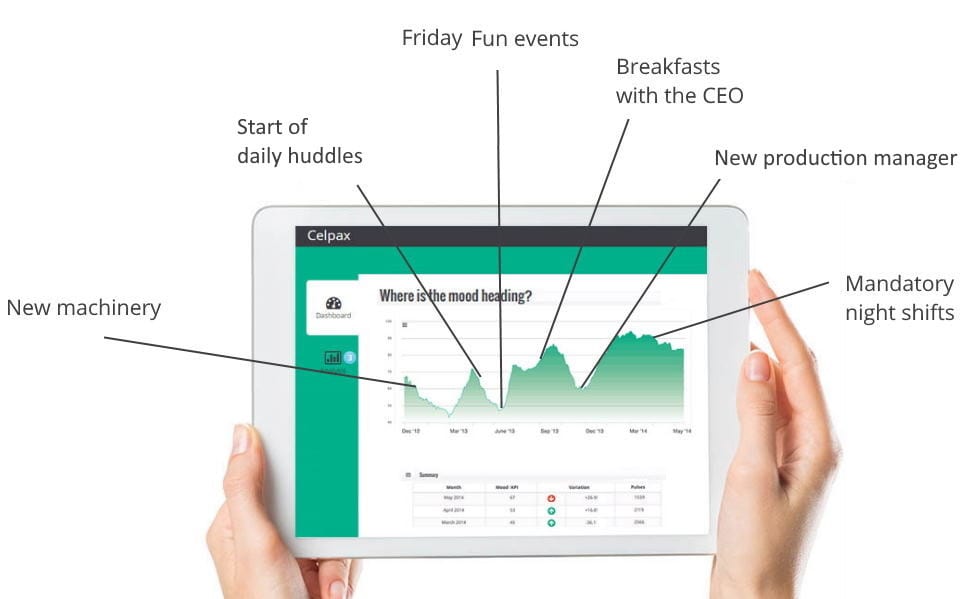Today we’re looking at examples of analytical leadership, and data-driven approaches to engage your team.
With the current Covid situation a lot has been written about crisis leadership and how to handle change.
There’s been less focus on day-to-day leadership. What happens when you prepare for big upcoming changes? It’s easy to lose track of the here and now.
On a normal business day, a leader encounters many situations, incidents, and KPIs to track, attack, and solve.
A data-driven leader mixes the best of the two worlds: hard data with great traditional people skills.
Let’s look at 5 data-driven approaches to apply analytical leadership and engage your team:
1. Frequency
It’s the frequency of the small things that you do that makes it so powerful. A fair share of leaders tends to think it’s all about big projects, big plans and big strategies.
Yet over and over again, when we hear what employees raise as concerns, they are very focused on the day-to-day. In a UK company of 30K employees, one main concern that was frequently brought up was how their managers would ride in the elevator with them up and not say good morning to the team members they shared the lift with. Day after day!
How do you expect people to follow you if you can’t even be bothered to say hello in the morning? The thing is, that irritation grows and grows among your employees.
What would be the impact on your company if more leaders would take the time to engage in conversations with their teams, and create a culture of raising their voices, bringing up what is bothering people instead of bottling it up? Next, you then try to solve it together. Before you know it, your team will bring up business improvements and proactive suggestions. Create better relationships at work and get a group of problem-solvers!
Improving with a survey once a year is obviously not a thing anymore in today’s fast-paced, data-driven business world. If you use a system that tracks daily employee mood, you can then verify the impact your leadership actions have on employee engagement. Both the impact the day that you organize a team meeting or the long-term impact of starting with daily team huddles.
2. Action!
The purpose of any data collection is clear: action. That is, for the collected data to actively influence decision making.
In the case of a data-driven approach to getting a more engaged team, the goal is for the feedback to translate into something concrete that will improve employee engagement. I.e. why collect data if you’re not going to use it? Analytical leadership requires actions.
Circling back to the frequency previously mentioned, it’s obvious that the more events and actions you take that target employee well-being, the faster you will improve.
One popular method is to put well-being on the agenda. As in open up your google calendar right now, and scheduled in some dedicated team time for the upcoming weeks.
What action would your team like to see? “People need to be encouraged to speak out. Even if what they say is not positive”, says the Production Manager at Metzo. He is one of many other leadership skills examples where managers use daily huddles and weekly meetings to maintain open communication channels.
They then decide on actions, together.
A recent survey showed not even 4 out of 10 organizations would describe themselves as “analytical companies” or “analytical competitors.” 67% of the respondent did not feel comfortable accessing or using the company data. How are your managers going to act if they don’t see the direct way to take actions? Mind the gap.
What do you need to start, stop and continue doing?
3. Validate Your Actions
So we already established that the more actions you take with analytical leadership, the faster you can improve team morale.
But what about the impact? Which of these actions have the biggest effect? And is this enough to move the needle over time?
There are many tools to measure the impact of your actions. One popular method is to use baseline measurements with a fixed point of reference.
That is, how was team morale before you started measuring, what was the starting point? And how does the data fluctuate over time? What is that impact team morale the most? With repeated measurements, data patterns emerge.
With baseline measurements, you can validate the actions that you take. Use the data analytics to shift to where you want to be with your team.

4. Repeat!
Creating a great team with analytical leadership is more like a marathon than a sprint.
It’s not enough to organize a Christmas lunch and an open-house day if you want to maintain team morale at a good level.
Find a healthy way to use the data insights, at a pace and rhythm that suits you and your team. When the baseline KPI shows a decline, do more. If it’s stable, you can relax a bit and shift your data focus to other areas that need improvement.
Good managers continuously improve together with their teams. And there is plenty of data solutions out there for it to be easy to use. No need to be a data analyst in order to use a data-driven approach to engage your team.
5. Transparent leadership
Last but not least, analytical leaders benefit from adapting a transparent approach. In which areas? ALL of them. Sounds scary? You bet.
Transparency is a strong consumer trend that is rubbing off on employees too.
If you encourage team members to collaborate and share information in your business, you need to do your part too. Be as transparent as you possibly can. Both with numbers and the data that you harvest, and how you as a leader feel in your organization.
Depending on how high you are in your organization, transparency might be hard to adopt. Particularly if this is not something that is embedded in your company culture and the current management style. But with an analytical leadership approach, you can faster create better relationships at work and get a group of problem-solvers. This in turn will lead to higher productivity.
And that means it will be easier for you to convince more leaders to adopt a more people-focused approach. This translates into more co-workers waking up and feel better about going to work.
Leadership -DepositPhotos


